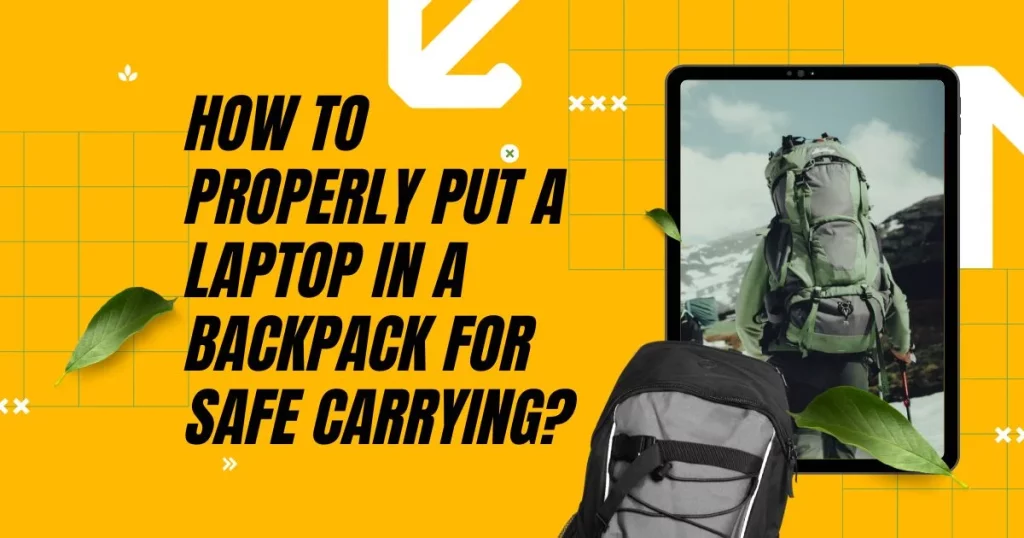How to Properly Put a Laptop in a Backpack for Safe Carrying?
Laptops remain essential for work, school, and entertainment, so it’s important to know how to correctly put a computer in a backpack to ensure its safety during transport.

Whether you’re a student commuting to school or an employee traveling for work, taking the time to pack your laptop correctly can prevent damage to your device and save you from costly repairs. In this article we will discuss How to Properly Put a Laptop in a Backpack for Safe Carrying.
Determine the Proper Backpack Size for Your Laptop

Before packing your laptop in a backpack, you must ensure the load is appropriate for your device. A bag that’s too small can put pressure on your computer and cause damage, while a backpack that’s too large can cause your computer to shift during transport.
Measure your laptop’s dimensions and compare them to the backpack’s compartment size to ensure a proper fit.
Clean Your Backpack Before Packing
Before placing your laptop in a backpack, clean the backpack’s compartments to remove any dust or debris that could scratch or damage your device. Use a damp cloth or a gentle cleaning solution to wipe down the backpack’s interior, paying particular attention to the laptop compartment.
Organize Your Backpack’s Compartments
Organizing your backpack’s compartments can make it easier to pack your laptop and prevent it from shifting during transport. Use the backpack’s designated laptop compartment, if it has one, and organize other bins to distribute weight evenly.
Use a Protective Laptop Sleeve
A protective laptop sleeve can provide extra cushioning and protection for your device. Place your laptop in the sleeve before placing it in the backpack’s laptop compartment.
Secure Your Laptop in the Backpack
When placing your laptop in the backpack, make sure to secure it in place to prevent it from moving around during transport. Use straps or other fasteners to hold your computer in place, ensuring it’s snug and secure.
Avoid Overpacking Your Backpack
Overpacking your backpack can put pressure on your laptop and cause damage. We have write a review on Best Charging Laptop Backpack. Make sure to pack the essentials and avoid stuffing your bag to capacity.
Use Extra Padding for Added Protection
If you’re concerned about your laptop’s safety during transport, consider adding extra padding to the backpack. Use foam inserts or other protective materials to provide an additional cushioning layer.
Carry Your Backpack Properly
When carrying your backpack with your laptop inside, distribute the weight evenly to prevent strain on your back and shoulders. Use both straps to hold the bag and adjust them so it sits comfortably on your back.
Avoid Placing Heavy Items on Top of Your Laptop
Avoid placing heavy items on your laptop in the backpack, as this can cause damage. We have write a complete guide on How to Protect Your Laptop in a Backpack. Make sure to organize the backpack’s compartments so that heavy objects are placed on the bottom and away from the laptop compartment.
Check Your Laptop After the Transport
After transporting your laptop in a backpack:
- Check it for any damage.
- Turn on the device and check for any hardware or software issues.
- If you notice any damage, seek professional assistance to prevent further problems.
What is a laptop sleeve in a backpack?
A laptop sleeve in a backpack is a special compartment designed to hold and protect a laptop while it is being transported in a bag. The sleeve is usually made of soft and durable materials, such as neoprene, which provides excellent shock absorption and protects the laptop from scratches, bumps, and other types of damage.
Laptop sleeves come in various sizes, shapes, and designs to fit different types of laptops, including ultrabooks, gaming laptops, and standard laptops. We have write a complete guide on Can Longchamp Backpack Fit Laptop. Some sleeves have additional features, such as pockets for carrying accessories like power cords, USB drives, and mice.
Using a laptop sleeve in a backpack is a smart choice for anyone who travels frequently or commutes to work or school. It provides an extra layer of protection for the laptop, ensuring it stays safe and secure during transport. It also helps keep the computer clean and free of dust, dirt, and debris.
Is it safe to put a laptop in a backpack?
Putting a laptop in a backpack is generally safe if you take the necessary precautions to protect your device from damage. However, it’s important to note that bags are not explicitly designed to carry laptops, so some risks are involved.
The main risk of putting a laptop in a backpack is the possibility of it getting damaged during transit. If you don’t have a laptop sleeve or protective case, the computer could get scratched, dented, or even cracked if it’s jostled around too much in the backpack. This is especially true if you have other heavy items in the bag that could damage the laptop.
Another risk is theft. Backpacks are more accessible to steal than dedicated laptop bags, which often have more security features. If you’re traveling in a crowded area or using public transportation, keeping a close eye on your backpack is essential to ensure that no one tries to take your laptop.
To reduce the risk of damage or theft, it’s recommended that you use a laptop sleeve or protective case in your backpack. We have write a complete info Does the Jansport Big Student Backpack Have a Laptop Sleeve. These accessories provide an extra layer of protection and help to keep the laptop secure and in place during transit. Additionally, it’s a good idea to choose a backpack with a dedicated laptop compartment, as this provides extra protection and makes it more difficult for thieves to steal the laptop.
How to protect your laptop from physical damage?
Protecting your laptop from physical damage is crucial to ensuring it stays in good working condition for years. Here are some tips on how to protect your computer from physical damage:
Conclusion
In the above portion of my blog, i have write a complete guide on ” How to Properly Put a Laptop in a Backpack for Safe Carrying “Properly putting a laptop in a backpack for safe carrying is essential for anyone who needs to transport their device regularly. Following the steps outlined in this article, you can ensure that your laptop remains safe and secure during transport, preventing damage and costly repairs.
